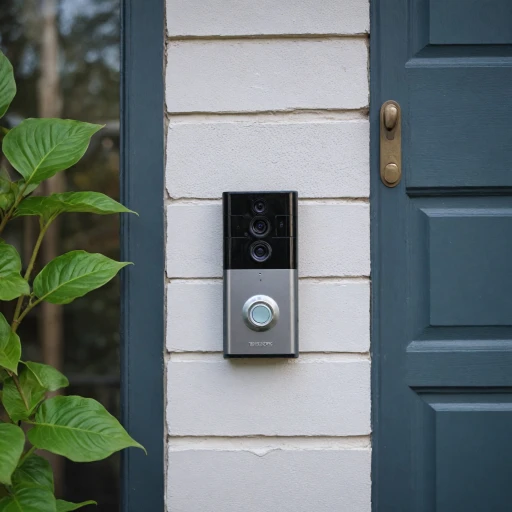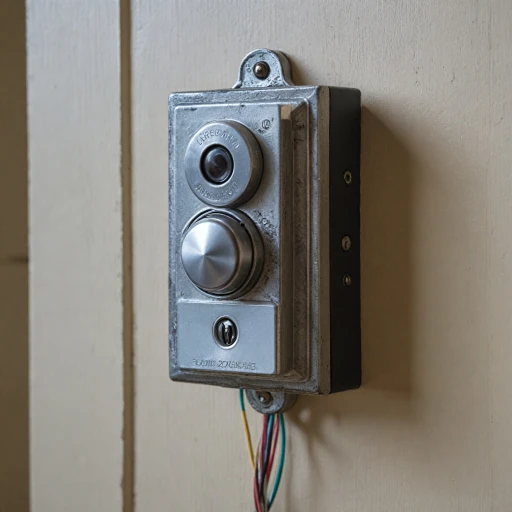What is a Doorbell Transformer?
The Critical Component Behind Your Smart Doorbell
For anyone considering the installation of a smart doorbell, understanding the role of a doorbell transformer is crucial. This integral component ensures that your doorbell receives the correct power to operate efficiently, especially those equipped with video capabilities. A doorbell transformer steps down the electrical power from your home’s main electrical panel to a lower voltage suitable for your smart doorbell and chime. Most traditional wired doorbells utilize a transformer to provide the necessary low voltage for the bell chime. This voltage is typically around 16-24 volts, a safe level for home use while providing adequate power to trigger the doorbell chime when the doorbell button is pressed. Wired doorbells, including video doorbells, require a reliable power supply, and this is where doorbell transformers play a pivotal role. By converting high voltage from the electrical box, transformers ensure that your smart device doesn't encounter power shortages or surges, which could impact its performance. Before delving into choosing the right transformer model or addressing common issues, it’s vital to comprehend this insightful guide on understanding the role of a doorbell transformer to acknowledge its significance fully and how it underpins the seamless functionality of your smart home technology.How Doorbell Transformers Work with Smart Doorbells
Exploring the Dynamic Between Doorbell Transformers and Smart Doorbells
Smart doorbells, particularly the video varieties, are gaining popularity due to their ability to provide real-time home security. However, these advanced devices require a structured power supply to function correctly. This is where doorbell transformers come into play. Smart doorbells are often wired and connect to a power source through a doorbell transformer. These transformers convert high voltage from your electrical panel into a lower voltage, suitable for both classic and modern bell chime systems. Typically, the transformed voltage is transmitted through the wiring to power the video doorbell and the connected chime. This conversion ensures that the smart doorbell operates efficiently, supplying consistent power without overwhelming the system. Transformers for smart doorbells can range in voltage output, usually around 16-24 volts, making them compatible with various wired doorbell models. The transformer's ability to provide a steady power supply is critical to maintaining the continuous functionality of the doorbell, especially when it comes to powering features like a lighted push button or a full product video doorbell. One of the key benefits of using a doorbell transformer in your setup is the ability to maintain low voltage in the system, ensuring safety while providing enough power to all enabled features. It's crucial when installing these transformers to pay attention to the product details and match the correct voltage output with your door chime and doorbell model. Chances to enhance the overall smart doorbell ecosystem lie in the proper installation of a doorbell transformer. Whether you're setting up a new wired doorbell or replacing an old chime transformer, understanding the interplay between these components can ensure optimal performance and extend the life of your smart home technology. It’s an integral step to ensure each push of the doorbell button results in a chime, keeping your home secure and connected at all times.Choosing the Right Doorbell Transformer for Your Smart Doorbell
Key Considerations for Selecting the Ideal Doorbell Transformer
When opting for a doorbell transformer, the decision hinges on multiple factors to ensure compatibility and efficiency with your smart doorbell. Grasping a few critical points can make the process smoother and enhance the functioning of your smart home device.
- Voltage Requirements: Different smart doorbell models require varying voltage levels. It's essential to check the specific voltage needs of your video doorbell, typically ranging from 16V to 24V, to ensure efficient operation.
- Power Output: Appropriate power supply is crucial for maintaining the performance of video doorbells and chime systems. A transformer supplying insufficient power may lead to issues such as chime malfunction or delayed doorbell response.
- Compatibility with Existing Wiring: If you have a wired doorbell system, it's important to consider whether the new transformer will integrate seamlessly with your existing wiring and electrical panel. Certain transformers are more adaptable and easier to install with older setups.
- Wiring Setup: Understanding the junction box and wire panel locations within your home helps in deciding the appropriate transformer. A more centralized location may be preferable for efficient wiring and power distribution.
- Model and Manufacturer: Look into doorbell transformers from reputable brands like Newhouse Hardware that are known for reliability, and check if they support a wide range of doorbell models for future-proofing.
By noting these elements, you will not only enhance the longevity of your doorbell chime and transformer doorbell but also avoid common issues such as incorrect voltage delivery or power shortages. Selecting the right transformer ensures seamless integration with your smart home setup, helping your door bell chime system perform optimally. Check out more about transformers on Understanding the Role of a Doorbell Transformer to deepen your understanding.
Common Issues with Doorbell Transformers
Frequent Challenges with Installing Doorbell Transformers
While installing a doorbell transformer is a straightforward task, certain common issues can arise that disrupt the functionality of your smart doorbell system. Understanding these potential pitfalls can help you ensure a seamless installation and operation.
- Inadequate Voltage: One frequent problem involves voltage mismatches between the power supply from the transformer and the requirements of the smart doorbell. If the voltage is too low or too high, the smart video doorbell or the bell chime might not function correctly. It is vital to choose a transformer that offers the appropriate voltage output compatible with your smart doorbell model.
- Wiring Complications: Faulty wiring can hinder the performance of doorbell systems. Incorrect wire connections in the junction box can lead to issues with the door chime operating or with the power reaching the doorbell button. Ensure that the electrical wiring is done properly and securely, following the product details for your specific doorbell.
- Placement and Compatibility: The location of the doorbell transformer matters. If installed too far from the main electrical panel or the door itself, it may cause power loss, affecting the doorbell's performance. Additionally, not all transformers are compatible with every doorbell model, particularly newer wired doorbells.
- Transformer Overload: Using one transformer to power multiple devices, such as lighting and the video doorbell, may lead to overload. This prevents adequate power from reaching the doorbell, potentially causing the system to malfunction. Always ensure that the transformer you install matches the overall power needs of all connected devices.
- Chime Transformer Issues: For those with a wired doorbell and separate chime transformer, ensuring compatibility between these components is crucial. A mismatch can result in the chime not ringing or only partially operating when the button is pressed.
Addressing these issues beforehand can save time and help maintain the reliability of your smart doorbell setup. Always consult with an electrical professional if you're unsure about any aspect of the doorbell or transformer install procedure to avoid unnecessary risks.
Installation Tips for Doorbell Transformers
Key Tips for Successful Transformer Installation
Installing a doorbell transformer is a critical step in setting up your smart doorbell system. Ensuring everything is done correctly will keep your doorbell, chime, and other components functioning smoothly. Here's what you need to know:
- Safety First: Before beginning the installation, make sure to turn off the power at the breaker panel to prevent any electrical hazards. Use a voltage tester to confirm that there is no live power at the installation site.
- Right Location: Choose a suitable location for the transformer. It can be screwed into a junction box or mounted onto an electrical panel. This ensures that the transformer is secure and well ventilated.
- Proper Wiring: Follow the manufacturer's product details for wiring the transformer. Typically, doorbell transformers have three wires: one to connect to the incoming power (usually black), one common wire (white), and one for the doorbell system's low voltage (red or another color).
- User-Friendly Components: Consider using a lighted push button for easy visibility at night, which can enhance the user experience and prevent missed visitors.
- Compatibility Check: Ensure the transformer meets the power and voltage requirements of your specific video doorbell model to avoid any compatibility issues that may affect performance.
- Testing the System: Once installed, test the setup by pressing the doorbell button. Ensure all components like the door chime, bell chime, and any video functionality are operational.
- Finishing Up: Secure any loose wires to prevent them from being pinched or causing damage to other installations. Make sure the box is properly closed after the installation is complete.
Following these steps can help ensure a smooth and efficient install of your doorbell transformer, ensuring that your smart doorbell and other components deliver optimal performance.
Future Trends in Doorbell Transformer Technology
Innovations in Transformer Technology for Modern Doorbells
As technology advances, the future of doorbell transformers continues to evolve. The integration of smart features into these devices has led to numerous improvements aimed at efficiency and convenience. Here’s a look at some of the potential trends shaping the future landscape of transformer technology in smart doorbells:- Energy Efficiency: Expect to see transformers designed to use lower voltage without compromising on power output. This not only helps in reducing energy consumption but also minimizes the environmental impact.
- Dashboard Monitoring: Future models may incorporate digital interfaces that allow homeowners to monitor the power flow and status of their doorbell system in real-time through an app or online panel.
- Intuitive Troubleshooting: Enhanced fault detection features could preemptively alert you to voltage issues or wiring errors, making maintenance a breeze and reducing the guesswork involved in troubleshooting.
- Modular Designs: As the trend shifts towards versatile electronics, modular doorbell transformers could provide seamless upgrades or repairs without the need to replace the entire system.
- Wireless Integration: While most doorbell systems are wired, wireless transformer models are anticipated. These will rely on Wi-Fi and other wireless technologies to eliminate the need for traditional wiring altogether.




